April 2009 Archives
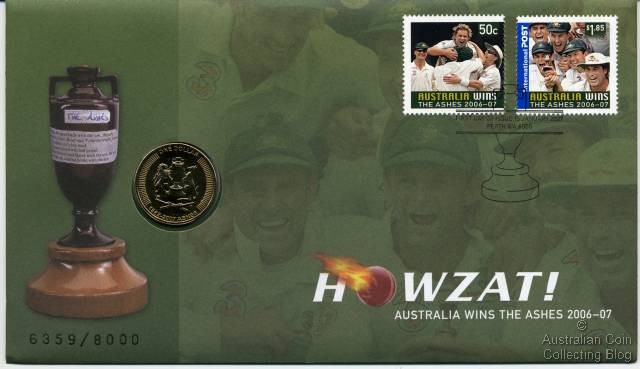 2007 The Ashes PNC
2007 The Ashes PNC
This coin was housed in a first day cover envelope featuring 2 stamps cancelled on their first day of issue 16 January 2007. This coin and PNC commemorated the Australians winning back the cricketers "holy grail' Ashes Cricket series trophy after it being lost for 2 years to the English. We had previously held the Ashes trophy for 16 years. The Ashes series has been in play between Australia and England since 1882 and the coin features the iconic Ashes Urn Trophy.
This was the very first philatelic numismatic cover (pnc) issued that had a limited mintage of covers. Each of these PNC's were numbered from 1 to 8 000. Each PNC also featured a small sticker on the reverse signifying it a genuine product endorsed by Cricketing Australia. Inside the envelope, a informative card housed the actual coin.
Initially there was much talk about this issue because of it's theme and limited mintage. At issue price of just $19.95 it was a must-have. Initially it seemed that stocks were limited and collectors, both numismatic, philatelic and cricket crazy rushed in to secure their PNC. This pushed the price up to record highs of over $150 and people rushed to check their local post offices to get consecutive numbered envelopes. Often in this situation there is plenty to go around but because of the initial rush so as not to miss out the price spiked. Now once sellers had a taste of the high price and buyers had paid a premium they wouldn't let their PNC's sell for much less. The price has settled down now from a low of $90 up to around $100-$120 but these still remain at a high cv of $175.
This issue sparked mass interest in PNC's and a new craze. Subsequent issues such as the Sydney Harbour Bridge PNC or the Lifesaver PNC sold well but haven't faired as an investment barely managing to fetch issue price on resale. This new craze brought about the backyard PNC maker wanted to cash in on the PNC rush. Thankfully after about 18 months, the great PNC hype has died down. Beware though if the RAM join forces with AP again, put a special stamp on an envelope and only make a limited number then everyone will come out of the woodwork to make their quick buck!
Coin collecting is a huge hobby around the world. The term for coin collecting or studying coins is numismatics. If you are an expert in coins then you are a numismatist.
There are a broad range of collectors out there from people collecting interesting commemorative coins out of their everyday change, collectors buying issues directly from various mint's around the world as collector pieces to the hardened collector searching for the finest known example of a particular issue. There are also those who collect as precious metal investment but the majority of these collectors are not collecting for the numismatic value of the coin just the intrinsic value watching as precious metal prices rise and fall hoping to make a dollar.
What you choose to collect is totally up to you. It's what appeals to you and the enjoyment you get out of it. There is a major difference in collecting for fun and collecting for investment.
Collecting for fun:
This suits all collectors from a small budget up to big bucks. Just keeping coins from your change doesn't take a lot of investment because in the end you can just spend your collection for face value and you haven't lost anything. This is particularly popular with beginner collectors or kids coin collecting. Keeping coins that appeal to you from your change or going to the bank and withdrawing some coins to go through can be very rewarding. Choosing to collect particular types of coins or denominations can also be exciting with the thrill of tracking down that elusive hard to get coin.
Collecting for investment:
This can really be hit or miss depending on what you choose to collect. Some issues skyrocket in price from their release and if you don't get in quick then you miss out. It's often impossible to pick when these will occur. Pre-decimal coins if stored correctly and in higher grade or the scarcer years or varieties will always appreciate in value. Decimal issues of lower mintage and higher grade are always sought after. Coins with military themes have almost always proved popular. Then there's the issues that you thought would do well but have totally flopped such as the lifesaver PNC after the Ashes PNC scrum. In general, circulation type of currency (not nclt) low mintage in high grades are the ones to look out for and keep for the future.
In an odd numismatic turn of events Downies has announced it has secured a "limited number" of specially struck one dollar gold coins featuring the mob of roos design. With no gold set being released in 2009 and a gold 50c being struck for a corporate order overseas just recently this new issue also follows along those lines. The coins have been struck by the Royal Australian Mint for an overseas "corporate customer" and Downie's have secured a number of these to offer their customers in Australia.
This proof dollar is the same as a regular dollar featuring Stuart Devlin's iconic mob of roos design and Ian Rank-Broadley's effigy of Queen Elizabeth II. It is the same 25 millimetre diameter as our circulating coin but is struck in .9999 pure gold with a global mintage of just 1000 coins issues. Containing 21.52 grams of gold at today's value is worth $865. This coin, with a $1995 price tag seems a bit overpriced to be going in my collection.
In 2000 there was a joint Numismatic/Philatelic Trade Fair held in Sydney and Canberra
September 15 to 28 coinciding with the Sydney Olympic games. It's name was Olymphilex. The Royal Australian Mint attended both venues with it's portable press striking coins to order for show patrons.
These dollar coins, not issued for general circulation are typical aluminium bronze coins, 25 millimetres in diameter weighing 9 grams. Neither of these coins feature a mintmark as we know it, but have a plain edge with lettering denoting the location of striking ie Sydney or Canberra. This is the only standard type coin to feature this although not a circulation coin, these have been known to turn up in change very rarely. The reverse Olymphilex design was sculpted by Wojciech Pietranik and the obverse of QEII by Ian Rank-Broadley.
These could be purchased from the shows for premium of $2 and now fetch around $15-$20 each.

2000 Olymphilex Dollar

Canberra Edge Lettering
In late 1999 the RAM released it's 2000 mint and year sets. The theme for this year was the millennium year with the 50 entc featuring a coloured Australian flag. Initially a small number of these sets were struck and buyers were caught out thinking it may be a low mintage year. These were snapped buy collectors who ended up paying a premium for these sets as there was believed to be a shortage. In 2000 more sets were struck and were snapped up by overseas tourists here to see the Olympics in Sydney or catch a fleeting glimpse of Queen Elizabeth II on her visit to Australia. It is assumed then that a lot of these sets left the country with tourists.
So despite the overall total mintage for these sets being quite large 106 394 for the mint sets (more than double of the year before) and 64 904 of the proof sets their catalogue value is quite high. For the mint set issued at $19.95 expect to pay around $100 for one of these or for the proof set issued at $64.75 expect to pay $250. This is for the 2 reasons talked about above,
- The initial demand which inflated prices from the start, sellers wouldn't part with their sets for any less after that, and
- a lot of sets left the country in the luggage of tourists.
The millennium 50 cent coin was released into circulation and a variety known as the 'millennium incuse flag 50 cent' was found.

Australia 2000 Victoria Cross Dollar in PNC
In a previous entry about collecting miltary themed coins brief mention was made of the VC dollar. This dollar was released in 2000 to commemorate the 100th anniversary of Australia's first Victoria Cross medal for gallantry being awarded to Captain Neville Howse on July 24 1900. Howse, born in the UK emigrated to Australia in 1889 and enlisted with the New South Wales Corps Medical Staff and travelled to South Africa to fight in the Boer War. There he managed to carry a wounded man back to safety despite having his horse shot out from under him and being continually shot at while carrying the man.
The Victoria Cross itself is an interesting medal. It is awarded for conspicious gallantry in the face of the enemy and came into being under Queen Victoria in 1856 and was awarded solely to British troops. As time went on it was awarded to British Commonwealth troops from Australia, New Zealand, Canada, and various other Commonwealth nations. This remained the case even when these countries became independent from the UK but remained part of the British Commonwealth. Originally struck to award bravery in the Crimean war against the Russians the Victoria Cross medals are reputedly struck from Russian cannons captured during the Siege of Sevastopol during the Crimean War.
Anyway, back to the Australian VC Dollar. Minted from a regular 9 gram, 25mm aluminium bronze planchet, the obverse depicts Ian Rank-Broadley's portrait of an older Queen Elizabeth II. The reverse, designed by Wojciech Pietranik depicts a Victoria Cross medal with the legend "Victoria Cross One Dollar". In small letters on either side of the medal is the caption "Capt. N. Howse 24 July 1900". The Victoria Cross dollar is hardly a scarce coin, with 49,979 being released in a collectors folder, and another 48,830 released in a postal numismatic cover (PNC). You can compare this with the mintage of various portable press mintmark dollars and the counterstamp dollars of 2008, which often have mintages of under 10,000, and sometimes under 5,000. Despite this, the VC dollar has the highest catalogue value of any of the non circulating aluminium bronze dollar (excluding error coins and VIP release folders). The 2009 McDonalds Australian Coin and Banknotes Handbook catalogues them at $285 in the collector folder and $325 in the PNC. These CV's are optimistic at best, usually the foldered coins and the PNC's go for $220- $280.
I can only speculate why it has the value it does. Military themed coins typically do a little better than most. But, if you compare the VC dollar with the 90th Anniversary of the Navy dollar of 2001 with a mintage of 62,429 and it's CV of $55, or the Vietnam Veterans dollar of 2003 with a mintage of 57,000 and a CV of $45 you can see that its' price is well out of proportion with it's mintage. Because I was not collecting coins at the time these were released I am not sure what the market conditions were at the time so why it is catalogued so high is something of a mystery. I do have one theory though.
The only thing I might compare the VC Dollar with is the comparitively overpriced Ashes PNC of 2007. In the first few days after release these PNC's were reputed to be a scarce item with supply problems and this saw the price quickly run up from the issue price of $20 to $120 within a week as collectors frantically tried to get hold of them. Prices spiked at over $150 briefly and when it became obvious that the supply was not as limited as first thought the price steadied and then dropped back a little. Of course by this time there was an established base of collectors and speculators who had purchased the PNC's at over $100 and were not willing to sell their covers at less than that. Hence the price has remained high ever since (but has not appreciated at all). In the time I've been watching the price of VC dollars (the last 3 years or so) the price that they have sold for has hardly changed. Perhaps a similar thing happened with the VC dollar upon its release.
Despite this, they are the 'key' date of the dollar series. Not because of the scarcity, but because of the price. They are not hard to get, there's always one or two on Ebay and almost all dealers who deal with decimal coins will have one available for sale. I dont know if they are a good investment, perhaps if you can get one at a low enough price, but certainly they are an item you'll need if you're completing an Australian dollar collection.
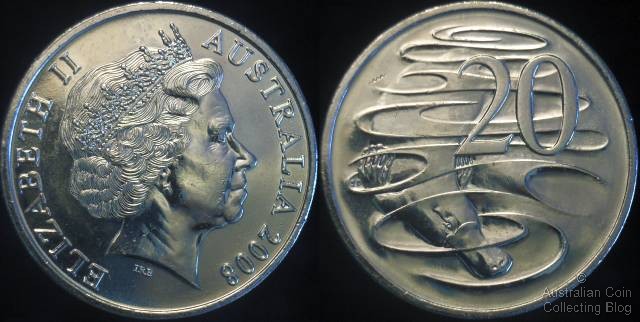
Australian 2008 20 cent Platypus Reverse
Aside from the Australian 50 cent and $1 coins the 20 cent is the only other circulation coin that you will find with a different reverse to the standard issue*. The obverse of the 20c has the usual portrait of Queen Elizabeth II, the Arnold Machin portrait from 1966 to 1984, the Raphael Maklouf portrait from 1985 to 1998, and the Ian Rank-Broadley from 1999 to present. The reverse of the standard issue pictures a swimming platypus designed by Stuart Devlin.
Like the values of Australian 50 cent coins the values of Australian 20 cent coins is largely dependent on the condition of the coin. Very few coins you might find in circulation will be worth anything more than 20 cents. I'll take a look at the standard issues before I cover the rarer varieties you could keep an eye out for.
The Australian 20 cent was only produced with the standard platypus reverse until 1995 when a smallish issue of 4.8 million coins was issued with a reverse commemorating the 50th anniversary of the United Nations. In 2001 another issue was released commemorating the life of Don Bradman. 2001 was also the Centenary of Australian Federation and nine 20 cent coins with different reverses were released celebrating this. Coins were released for New South Wales, the ACT, Queensland, Victoria, Norfolk Island, the Northern Territory, Western Australia, South Australia, and Tasmania. Most of these coins had an issue of 2 million coins, for some reason the Queensland and South Australian coins had a mintage of 2.3 million. Interestingly the reverse designs of the coins were the result of student design competitions in the schools of the respective states and territories of each coin.
2003 saw the release of a 20 cent celebrating the Year of the Volunteer (7.5 million minted), and 2005 a coin commemorating the 60th anniversary of World War II (32 million minted). In 2007, for the first time, there was a unique 20c issued in the uncirculated mint set (the Year of the Lifesaver), the same coin was also issued in a PNC. 2008 saw the cynical release of the two coin uncirculated coin sets by the RAM in addition to the normal uncirculated coin sets. This two coin set contains a unique 20 cent (the Year of Planet Earth) and the exercise was continued in 2009 with the Year of Astronomy 20 cent in the uncirculated two coin set.
Of the commemorative 20 cent coins mentioned above the United Nations, Bradman, and Centenary of Federation coins, if found in circulation may fetch a dollar or two each on Ebay. Truly uncirculated examples will get a dollar or two more. Catalogue values for each of these coins is only $6-$7 in uncirculated condition. The 2003 Volunteers and 2005 World War II 20 cent are worth face value, this is despite of how infrequently they show up in your pocket change. The mint set only coins, will very rarely (if ever) be found in circulation. The only real way of getting them is by getting a mint set and cutting them out of the set. Sometimes you'll see individual coins available on Ebay because some people break up the mint sets to sell the coins and try to make a profit. Expect to pay $10-15 for one of them, and to receive about the same amount if you sell one.
In the next part of this entry I'll cover some rare varieties of the 20 cent you can look out for in your pocket change that are worth a tidy sum.
*At the time of writing. Update July 2013. There have now been $2 coins with commemorative reverse designs issued.
Why is it that the majority of coin storage products out there are primarily made with PVC? Coin collector specific albums and pages made with PVC are aimed at the majority of collectors who are not aware of potential problems associated with buying the wrong storage options. Dealers shelves are packed with pages and albums that have no place near your coin collection.
We are becoming increasingly aware of how PVC damages coins. Pull out your albums after just a few years of storage in seemingly safe 2x2 holders and see how the pvc from the album page has permeated through the mylar 2x2 and onto the coin surface. It will have created a scum or strange toning on the coin often green on silver coins
.
Through the late 60's, 70's and early 80's the RAM uncirculated mint sets were issued in pvc folders. Most likely now if you've left your coins in these folders they're ruined. The coins will be stuck in the folder engulfed in a sticky ooze.
PVC or polyvinylchloride is the problem factor with these storage products. It is a non-recyclable plastic that deteriorates with age. Through time pvc breaks down becoming unstable leeching chemicals directly onto your coins surface or through other safe plastics.
Certainly there needs to be a better way to store your coins and while slabbing coins or using airtites or eagle mounts, capsules or intercept shield holders are all great, collectors often have bulk coin that needs to be stored safely. Not all coins in your collection deserve the royal treatment of slabbing!
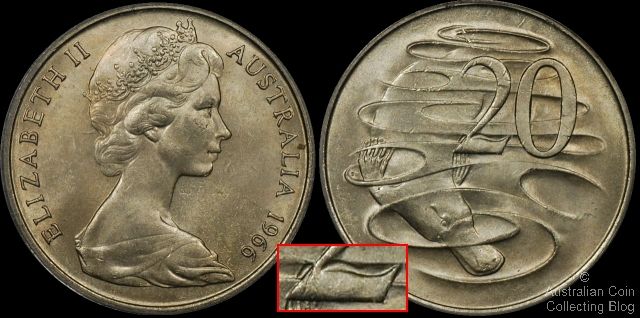 1966 Wavy Baseline 20 cent PCGS MS64
1966 Wavy Baseline 20 cent PCGS MS64
If you find an Australian 1966 20 cent piece in your change then you'd better take a second look. Did you know that a particular variety of the 1966 20 cent coin could be worth $100 or more!
In 1966 the 20 cent piece was minted in 2 different locations. About half of those coins were minted in Canberra and half in London at the Royal Mint in Birmingham. Of the 30 million coins minted in London just one of the dies that were used to press those coins was different. There was a small difference that makes this coin unique and worth a great deal more.
The oddity is that one die had a small differing feature. This variety is in the base of the 2 of the 20 on the reverse of the coin. There is an upward curve in that baseline of the 2 often called a wave, thus the nickname the 'wavy 20' or 'wavy baseline 20 cent'.
Beware there are many forgeries around mimicking this wave often derived from some sort of heat treatment of the metal. A genuine wavy 20 has a gentle curve that is paralleled in the water swirl directly above.
A high grade example of one of these varieties is worth $3000-$5000 whilst a banged up coin you might find in your change might be worth around $100.
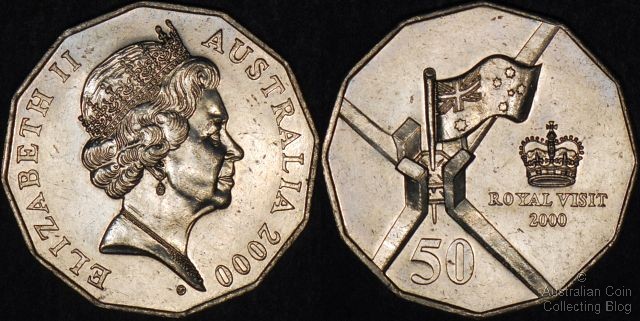
Australia 2000 Royal Visit 50 cent -found in change
To commemorate the official visit by Her Majesty Queen Elizabeth II in 2000 a special 50 cent was struck for circulation.
The reverse design featured the flag pole at Parliament House in Canberra ACT flying the Australian flag and a small St Edward's Crown. This crown is believed to contain gold from the crown of Edward the Confessor, who is thought to be the first monarch to assemble a regalia.
The most interesting fact to note about this coin is it's obverse design. It is an entirely different design to all other effigies on our decimal currency. In 1996 the RAM was invited to submit designs for an update to the portrait of Her Majesty on the obverse of Commonwealth coinage. The RAM's in house designer at the time Vladimir Gottwald submitted his design and was among the final 3 viewed by the Queen herself for approval. Although the Ian Rank-Broadley effigy was chosen, Gottwald's design was approved for a one time striking on this 2000 Royal Visit 50 cent.
Royal permission for the use of his design on the coin was only granted from Buckingham palace on the eve of the Queen's visit. For the first time in Australia since 1936 an obverse was created by an Australian designer.
It is truly a unique issue being the only Australian coin with this portrait and also that this coin was designed entirely by Vladimir Gottwald, both the obverse and reverse sides.
Ammendment January 2011: This same Vladimir Gottwald obverse was used on all the coins in the 2010 gold year set commemorating 10 years since this obverse was used.
It's interesting that decimal currency hasn't brought abbreviation of our coins and notes like there was with pre-decimal money that I found out when I dived into some in depth research into slang monetary terms. It's interesting and amusing how some of these slang terms came about and even with the differing countries how their slang is just like a foreign language to us. These are just some of the Aussie slang terms, there are more and interesting terms used in other countries derived from their histories and cultures.
Do you remember slang terms used for monies in days of old?
Threepence: tray or trey bit or trey, comes from the french tre meaning three.
Sixpence: zac or tanner.
Shilling: bob or deener or dina.
Florin: two bob or sly.
1937 or 1938 crown: casey's cartwheel -named after the treasurer of the time Lord Casey who proposed the coin.
Ten shillings: half-fidly
Pound: quid or fiddly- derived from word association fidly->fid->quid.
Five pounds: spin
Ten pounds: brick.
Slang term for the first Australian pre-decimal notes when Fisher was the Prime Minister: Fisher's flimsies
Pre-decimal notes with Miller as one of the signatories: Miller flimsies
One dollar coin or note: buck.
$20 note - lobster or red-back
Even the term heads and tails is a slang term. The general population probably wouldn't recognise the tails side as the reverse and the heads side as the obverse of coins.
In the year 2000 Sydney Australia hosted it's first Olympic games since the 1956 Olympics in Melbourne.
A string of $5 coins were released in a joint RAM/Perth Mint venture each commemorating different aspects of the Olympics.
28 Aluminium bronze five dollar coins were issued featuring different sports of the Olympics, these were each housed in a small plastic card with mintages of 100 000 each.
Other Olympic issues just commemorated Australia - it's flora, fauna and culture. These were 24 silver proof coins available individually or in mini sets of each theme. Interestingly 2 of these coins the 'Festival of dreaming' and 'A sea change' were designed based on original sketches by Nova Peris-Kneebone, our own Aboriginal athlete and artist. There was a complete gold version of this set issued also.
Hundred dollar denomination issues depicted our journey through Sydney 2000. Eight gold coins from journey begins, dedication (2), preparation (2), stadium, achievement - athlete and achievement - torch.
The finale of the Olympic coin program was an impressive $30 99.9% silver proof coin weighing in at 1 kilogram! At the time it was the biggest Olympic coin ever struck at 100 millimetres in diameter and such was a talking piece at the World Money Fair in Basel, Switzerland.
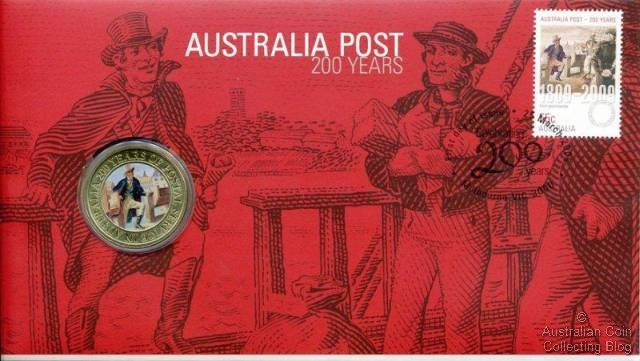 Bicentenary of Australia Post PNC
Bicentenary of Australia Post PNC
This postal numismatic cover features a Perth Mint one dollar coin and a 55c stamp on an illustrated cover. The dollar is a non-circulating coin but it is officially legal tender. It has a coloured reverse design representative of Isaac Nichols. The commemorative stamp is postmarked with the anniversary date 25 March 2009.
This PNC has an issue price of $14.95 with no stated mintage numbers. There has been quite a decline in the pnc market lately after the great pnc excitement of 2008. Personally I think there's no real investment in obtaining this pnc and isn't likely to rise in price any time soon.
I've always been told that if I wanted to sell my collection at any time the best way to sell would be to use one of the big auction houses and consign my collection for sale at their next public auction. This sounds like the best way to go as buyers can freely view the items at pre-sale viewings and you are selling to a specific customer base brought in by the reputation of the auction house.
Did you ever think how much this was going to cost and how much the auction houses were actually going to take out of my pocket and the buyers??
To list your items in a public auction here's what you'll pay:
- A fixed listing fee for each lot submitted
- A percentage rate of the final sale price
Here's what the customer will pay:
- A buyers premium (commission charge) which is a % on top of the sale price
- Payment by credit card will incur a fee
- Shipping and handling charges
- A service charge on any overdue accounts
The auction houses do have their marketing costs such as the costs printing of the catalogues to take into account but think about how much they will make out of the sale of your collection.
At the very minimum they will make:
- $7 per lot listed from you AND
- 15-20% sellers charge on sale price AND
- 15-20% buyers fee
Just out of interest the buyers premium for a public auction sale back in 1999 was as low as 5%! It's crazy how much these costs have increased.
Of course if you have a high ticket item for sale the auction houses can be open to negotiation on their fees.
There are always positive and negative scenarios for each methods of selling buy it's no wonder people are steering towards sites such as eBay to sell their items, even with their fees it seems it's still cheaper than selling at an auction house.


